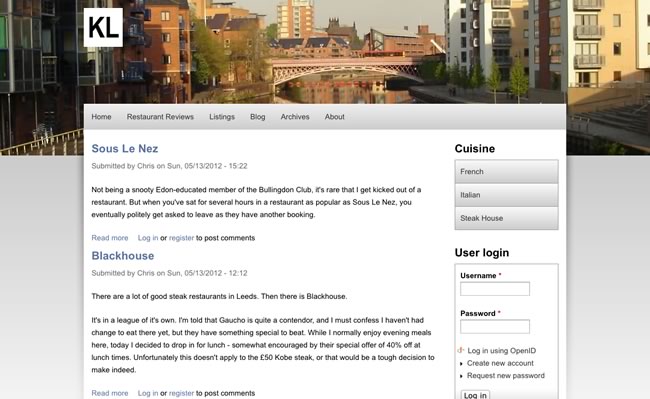Drupal is probably the best PHP-based CMS (content management system) on the market today. However, because it has a somewhat steeper learning curve than other systems, where you can just install and start creating content, it is easy to get frustrated with it and give up.
However, a short amount of time getting your head round the basics should be enough to show you that Drupal has some really powerful features which make it a far better CMS than those that simply allow you to drop text into pages.
We used Drupal to build Know Leeds and it allowed us to quickly and easily put together a functional site that allowed the non-technical contributors to get to grips with the system.
Content types
Because most people are familiar with WordPress, I’m going to use that as a comparison throughout this article. If you’re not familiar with WordPress, don’t worry, because most, if not all of the terms used are generic concepts that you will be able to understand anyway.
In WordPress, you have two types of content – posts and pages. Posts are the bread and butter of what was traditionally a blogging only system. Pages, are similar, but are static and don’t go into the date-based archives.
In Drupal, you get to define your own content types. It comes pre-configured with an article (similar to a post) and static page content types, but where you go from there is up to you. There are two good examples of where we used this in Know Leeds.
Firstly, we added a content type for “Restaurant Review”. This is similar to the Article content type, but we wanted to add some additional fields to Restaurant Review that didn’t want to be in Article – a star rating and a categorisation of what type of food the restaurant served.
Secondly, we added a content type for “Place”. We offer listings of local bars, clubs and restaurants on the website and if you think about it, an entry for one of these is basically just a piece of content. But with different needs than an article – we need address, phone number, email address, etc. So we created a custom content type for that too.
Fields
As I discussed with our custom content types, we wanted to customise the field types on our content types. In WordPress there are a number of fields – title, body, published date, categories, etc. In Drupal, you have the same thing, but you can create your own fields and match them to each content type.
So for the Restaurant Review content type we added a star rating field. This allows the editor to enter a numeric value between one and five. We also added a Cuisine content type which allows them to pick what kind of food it is. This works just like the WordPress categories system, except we can have multiple types of categories and we can pick which content types they apply to!
Taxonomy
In WordPress, there are two types of taxonomy – categories and tags. In Drupal, surprisingly enough, you can define your own. As I’ve already discussed, we created a Cuisine taxonomy and added a list of different terms (or categories if you will) such as French, Italian and Steak House.
Drupal allows you to create as many different categorisation systems as you wish and apply them to the content types as appropriate. We only wanted Cuisine to apply to the Restaurant Review content type for example, but Category might apply to both Article and Restaurant Review.
Blocks
Units of content which can be placed somewhere in your layout are called Blocks. The nearest equivalent to this in WordPress is the “widgets” system where you can drop widgets in and out of the sidebar.
Drupal comes with some standard blocks such as user login and search form, and many of the modules you can add into Drupal will add some blocks too – adding the forum module will add an “active forum topics” block for example. Of course, you can create your own custom blocks too.
You can then define where these appear – first sidebar, second sidebar, footer, navigation menu, etc, by selecting their position from the blocks menu. You can even do this on a theme by theme basis – on one theme you may want the search form to go in a sidebar for example, in another theme you may want it to go at the top or bottom of the page.
Unlike the widgets system in WordPress though, everything is a block in Drupal! Even the main page content so for some reason if you wanted to make your footer text display in the centre of the page and your main content display in your sidebar – you’re just a couple of clicks away from that!
Menus
Menus probably need the least explaining of all – it allows you to create menus which people can navigate around the site with. It is worth noting though, that items don’t appear in the menu automatically – you have to request that a piece of content (usually a static page) is given a menu link when creating or editing that piece of content.
Of course, you can create as many different menus as you want, assign different content (or any other links you want to add!) to different menus, and have the menus display in different places around your layout using the blocks system.
Conclusion
I hope this has presented you with a quick introduction to the fundamental concepts of Drupal. It is far more customisable that most other popular content management systems and as such has a steeper learning curve, but far more flexibility once understood.



